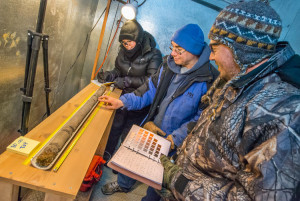A review of studies to better understand effects of climate change on microbial activities.
The Science:
Researchers are harnessing strategies including metagenomics to learn more about the microbial communities in permafrost and their current and potential responses to climate change.

Berkeley Lab Earth Sciences Division researchers working on a permafrost core from the NGEE Alaska project at the UC Richmond Field Station’s Cold Room Facility. (Roy Kaltschmidt, Berkeley Lab)
The Impact:
Researchers estimate that permafrost covers a quarter of the plant’s land area, and currently holds the same amount of carbon trapped in both the Earth’s vegetation and atmosphere combined. The potential impacts of having such a massive amount of carbon released when the frozen soils thaw on the global carbon cycle merit the attention of scientists studying microbial communities in the permafrost regions.
Summary
Permafrost is generally defined as soil that has remained frozen for at least two consecutive years, though in some regions the soil has been frozen for a couple of million years. These soils lie under what researchers refer to as the “active layer,” soil that can vary in depth from centimeters to several meters, and which is subject to seasonal freeze-thaw cycles. An estimated 1,672 billion metric tons of carbon is sequestered in the permafrost, which is thought to account for a fourth of the planet’s land area. In recent months, reports from both the Intergovernmental Panel on Climate Change and the U.S. Global Change Research Program reviewed the increase in greenhouse gas emissions such as carbon dioxide and methane since pre-industrial times and stressed the need to prepare for and address the effects of climate change. To this end, a review article published ahead online May 12, 2014 in Nature Reviews Microbiology, Lawrence Berkeley National Laboratory microbiologists Janet Jansson and Neslihan Tas sum up the findings on studies done thus far involving the microbial ecology of permafrost.
Several studies have focused on learning about the microbial diversity in the permafrost, and how these psychrophiles have adapted to survive conditions of extreme cold and low nutrient levels. For example, studies conducted as part of the Next-Generation Ecosystem Experiment in Barrow, Alaska found the microbial diversity was lower compared to the active layer in the area. However, the microbial populations were more diverse in Alaska compared to the samples taken in Antarctica, where a handful of bacteria dominated in the mineral soils of the McMurdo Dry Valleys.
Other studies have focused on tracking microbial activity through changes in methane and carbon dioxide levels. In the Canadian tundra, for example, such fluxes indicated that continuously active microbial populations thrive in the presence of ice wedges.
Finally, some studies offer hope for a positive response to a thawing permafrost. One metagenomics study revealed that when the permafrost thaws and the methane and carbon dioxide gases are released, the microbial composition of permafrost shifts to resemble the microbial composition seen in the active layer. “Much of the methane was subsequently consumed by methanotrophic bacteria,” the researchers reported. “This example highlights the importance of understanding the sources and sinks of greenhouse gases in a warming climate.”
Contact
Janet Jansson
Lawrence Berkeley National Laboratory
[email protected]
Funding
- U.S. Department of Energy Office of Science
- DOE-Next Generation Ecosystem Experiment (NGEE Arctic)
- Danish Center for Permafrost (CENPERM)
Publication
Jansson JK and Taş N. The microbial ecology of permafrost. Nat Rev Microbiol. 2014 May 12. doi: 10.1038/nrmicro3262. [Epub ahead of print]